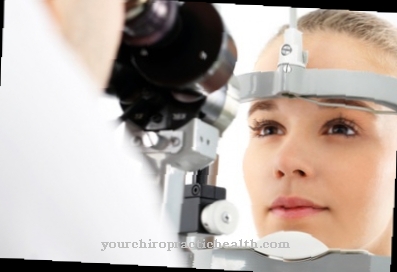The Cranio-Sacral Therapy or Skull and sacrum therapy is one of the alternative medical forms of therapy. It is a manual treatment in which hand movements are mainly performed in the area of the neck, skull, sacrum, spine, feet or pelvis.
What is Cranio-Sacral Therapy?

Cranio-Sacral Therapy originated from craniosacral osteopathy, the founder of which was the American doctor William Garner Sutherland. Sutherland was of the opinion that the skull bones of adult humans are not rigid but flexible. He carried out many personal experiments as well as tests on third parties and was able to feel the so-called craniosacral pulse - minimal rhythmic movements - on the human skeleton.
He also discovered that the movements of the sacrum were synchronized. Today's expression goes back to the osteopath John E. Upledger, who published a book in 1983 with the title "Craniosacral Therapy". Upledger observed the rhythmic movement of the cerebral and spinal cord skin (dura mater spinalis) as part of a spinal surgery, which enabled Sutherland's teaching to be further developed. Upledger designed a concept that consisted of ten individual steps and that he combined with alternative psychotherapy. He called this concept "Somato Emotional Release".
The cranio-sacral system envelops the spinal cord and the brain and is made up of the cerebrospinal fluid, the three meninges, the cranial bones and the spine. This system represents the "inner milieu" for the growth and function of the brain or the spinal cord. The connective tissue is the link between the peripheral parts of the body and the cranio-sacral system. If there is an increased tension in one of the systems, this is transferred to the other systems via the connective tissue and has an influence on their functions.
The tension reduces the flow of energy and the circulation of body fluids. With the help of cranio-sacral therapy, the tension in the cranio-sacral system can be balanced and self-regulation can be promoted. The cranio-sacral therapy is made up of the following basic elements:
- energetic techniques
- structural work on connective tissue
- Language as a means of expression and communication
- the organism and its possibilities of expression
- the somato-emotional relaxation
In the last twenty years, cranio-sacral therapy has experienced an upswing, as many physiotherapists, masseurs and alternative practitioners have shown interest in this form of therapy
Function, effect & goals
The skull and sacrum therapy is a very gentle but effective method to free the body from blockages and pain.This form of treatment is a kind of link between alternative and conventional medicine. The cerebrospinal fluid that circulates in the spine and in the skull serves as an indicator. The therapist can feel the rhythmic own movement and thereby release blockages.
The cranio-sacral therapy is carried out on a treatment table, whereby it is assumed that there is a disorder in the cranio-sacral system. This system includes the sacrum, the spine, the meninges, the cranial bones as well as the cerebrospinal fluid. The cerebral water flows around the spinal cord and the brain in the so-called liquor spaces. A wave travels 6 to 14 times per minute from the skull to the sacrum, which is known as the craniosacral pulse. Supporters of this form of therapy are of the opinion that this flow of energy indicates the mobility or order of the cranial skeleton.
If the cerebral water flow changes, a wide variety of symptoms or diseases occur. Both acute and chronic complaints such as spinal column and pelvic complaints, migraines, complaints in the neck, pain due to accidents, learning and concentration disorders in children, problems in the ENT area, psychological problems or birth trauma are treated. The therapist tries above all to promote the vegetative flexibility of the patient. This term describes the ability of the autonomic nervous system to react better to stress factors. The autonomic nervous system maintains extremely important functions, the main components being the parasympathetic and the sympathetic nervous system. The sympathetic nervous system stimulates the circulation, while the parasympathetic nervous system is responsible for relaxation.
If the sympathetic system is overstimulated, stress symptoms such as increased pulse rate, high blood pressure or digestive problems occur. To neutralize this state of tension, the parasympathetic nervous system is activated as part of a cranio-sacral therapy, so that the patient is able to relax again. In addition, cranio-sacral therapy conveys an understanding of the holistic nature of the human being. This can promote self-awareness and stimulate self-healing and self-regulation processes. Basically, Cranio-Sacral Therapy is suitable for all age groups, with the aim of restoring the balance of the cerebral water rhythm.
The therapist tries to feel the craniosacral rhythm of his patient by palpating the skull or the sacrum. The sources of interference are then resolved by massages or gentle pressure. The emotional, mental and physical tension is reduced in the course of the treatment and the self-healing powers are stimulated. A session lasts about an hour, an entire therapy consists of two to 20 treatments, with an interval of seven days between two sessions.
You can find your medication here
➔ Medicines against tension and muscle painRisks, side effects & dangers
Serious medical conditions could be overlooked in patients who only rely on this form of therapy. Therefore, treatment should always be carried out in consultation with a doctor.
Cranio-sacral therapy is not suitable for people who suffer from increased intracranial pressure or cerebral hemorrhage. When treating newborns, there is a risk of injuring the brain, as they still have widely spaced gaps between the skull bones. Overall, however, the therapy is very pleasant and involves hardly any risks.


.jpg)






















.jpg)


